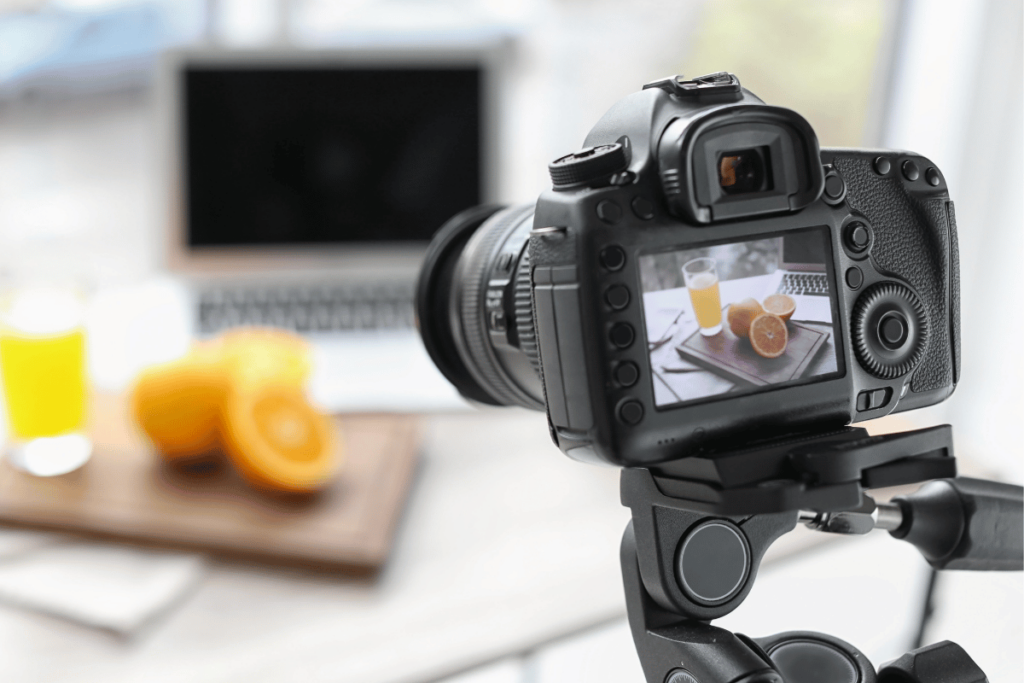
Mirrorless cameras are like the sleek cousins of the bulkier DSLRs. They ditch the mirror mechanism for a lighter, more compact design. But it’s not just the size that’s different; it’s what’s inside that counts.
At the heart of this innovation is the EVF, or electronic viewfinder. DSLRs have an optical viewfinder. Unlike that, an EVF shows a digital image from the sensor. You’re seeing a real-time preview of your shot, exposure, and all.
In this article, we’ll delve into the nitty-gritty of Mirrorless Camera EVFs. We’ll help you decide if a mirrorless camera is your next photographic companion.
What are the Advantages of an EVF?
Real-Time Previews
Has a photo ever blindsided you by not resembling what you saw in the viewfinder? With a mirrorless camera’s EVF, what you see is truly what you get. Live exposure previews mean you’re not guessing how your shot will turn out. The EVF provides a real-time histogram. It helps you nail the exposure before you even press the shutter.
Focus Peaking and Magnification
Say goodbye to missed focus shots. The EVF enhances your focusing game with focus peaking and magnification. These nifty features highlight the edges of contrast. They show you exactly what’s in focus. It’s like having a focusing superpower. Manual focusing is a breeze, even in tricky lighting.
Steady Shots with Image Stabilization
Remember those shaky handheld shots? EVFs often work in tandem with in-body image stabilization systems. This gives you a steadier, less blurry view, even when your hands are jittery. The camera also has an eye sensor. It automatically switches between the screen and the viewfinder. You’re shooting smooth and fast.
Customization at Your Fingertips
Want your viewfinder to show more than just the image? EVFs are king when it comes to customization. You’ll have a wealth of information and settings right before your eyes. You can tweak your display to show exactly what you need, when you need it. You can adjust battery life and exposure settings.
A New Perspective on Photography
Your mirrorless camera’s EVF isn’t just a tool; it’s a portal to precision photography. It invites you to explore new creative angles. You can make informed adjustments on the fly and capture moments with confidence. EVFs provide a dynamic and interactive shooting experience. Unlike the optical viewfinders in DSLRs. This mirrors the digital age.
What are the Disadvantages of an EVF?
Battery Life Blues
EVFs are notorious for their battery consumption. An optical viewfinder needs no power to function. In contrast, an EVF is an electronic device. It draws power every time your eye seeks a perfect shot. The constant feed of digital data can drain your battery faster than you might expect. It’s always smart to pack an extra one or two.
Keeping It Real…Time
Lag can be a real dampener when you’re trying to capture life’s spontaneous moments. EVFs often suffer from a slight delay in the display of the live image. This might lead you to miss a swift action or an ephemeral expression. Sure, technology is improving. That fraction of a second can be the difference between a good photo and a great one.
Through the Looking Glass
Resolution and color accuracy are other areas where EVFs might not always hit the mark. Your mirrorless camera’s EVF could be less sharp or vibrant compared to the final image. Manufacturers are always innovating. But if you’re a stickler for detail, you might sometimes feel like you’re not getting the full picture.
Seeing the Light
Outdoor shoots can throw another curveball—brightness and visibility issues. On a day that’s brighter than your future, squinting into an EVF can be as effective as sunglasses at midnight. Some EVFs come with adjustable brightness. However, it may not always combat tough sunlight.
Size Matters
Lastly, the size and weight of a mirrorless camera EVF setup can be a double-edged sword. The added components might bulk up your gear. This defeats the purpose of going mirrorless for portability.
OVF vs EVF: what’s the difference?
When you’re delving into photography, you’ll face the OVF versus EVF debate. Each has its own set of perks and quirks.
Understanding Optical Viewfinders
With OVFs, what you see is, quite literally, what you get. Light travels through the lens. It bounces off a mirror and dances through a prism. Finally, it hits your eyes. This zero-lag, real-time composition makes OVFs a staple in the photography world. Cameras like the classic Canon 5D Mark III employ these trusty OVFs.
Embracing Electronic Viewfinders
Let’s talk about EVFs often found in mirrorless cameras. These nifty gadgets display your image electronically, straight from the sensor. So, real-time previews, focus aids, and a plethora of information are at your disposal. The Sony Alpha series is a prime example of mirrorless wonders. They have sophisticated EVFs.
Resolution and Clarity
Resolution plays a vital role. EVFs have made leaps and bounds. Many models boast millions of dots for a crisp view. However, OVFs often take the cake with the unbeatable clarity that comes from a pure optical path.
Exposure Preview and Low-light Performance
The exposure preview of an EVF is invaluable. It shows you exactly how your settings will affect the final shot. Low-light conditions? EVFs amp up the brightness so you can see your scene, while OVFs might leave you squinting.
Weighing Battery Life
Battery consumption is a hot topic. EVFs are notorious power guzzlers — the screen and sensor combo eats up juice faster than an OVF would. Yep, that means carrying extra batteries should become your new norm.
Additional Features and Information
EVFs are the multi-tool of viewfinders. Histograms? Check. Overexposure warnings? Got ’em. Digital zoom for focus? You bet. These snazzy features turn your mirrorless camera’s EVF into an on-the-fly image lab.
As you compare these viewfinding visions, remember your style is unique. Your choice might hinge on quirks that cater to your shooting needs. Whether it’s the charm of an OVF or the high-tech allure of an EVF, each will lead you to capture the world through a different lens. No conclusion is needed.
How to Choose between EVF and OVF
Consider Your Photographic Style
Your choice hinges on what you capture through your lens. If landscape photography is your passion, the clarity and natural perspective of an OVF might be enticing. An EVF can be priceless for wildlife or sports, where timing is crucial. This is due to its focus aids and exposure preview.
Weigh Shooting Habits
Reflect on how you shoot. Do you prefer the stability of a tripod, or are you always on the go, camera in hand? Tripods and OVFs are a match made in heaven for meticulously framed shots. EVFs thrive in handheld, dynamic environments. They provide valuable real-time data to make the quick adjustments needed.
Personal Comfort and Preference
Don’t overlook comfort—if you find yourself squinting into an EVF or missing the ‘organic’ feel of an OVF, listen to those cues. Eye strain is real, and so is your enjoyment while shooting. Whether you yearn for that digital interface or crave the feel of analog equipment, it’s your vision that will guide your decision.
Each has its own set of virtues that cater to different styles and preferences. Your mission is to identify which one aligns seamlessly with your approach. It enhances not just the quality of your work. It also adds pleasure to capturing fleeting moments through your unique perspective.
How to Choose the Best EVF for Your Needs?
When you’re delving into the world of mirrorless cameras, the EVF – or electronic viewfinder – becomes a significant consideration. To ensure you’re getting the most bang for your buck, these are the things to keep in mind.
OLED vs LCD
First up, the type of display. OLED viewfinders are known for their rich, vibrant color contrast. They also perform better in low light. However, LCD is a more cost-effective option. It offers decent quality without breaking the bank. It’s all about what catches your eye, quite literally.
Magnification and Eye Point
Next, let’s talk size… of the image in the EVF, that is. Magnification is key. A higher magnification means a larger, more immersive view of your subject. The eye point is the distance from the viewfinder at which you can see the entire image. It is crucial for glasses wearers. You’ll want a comfortable eye point so you can see the full frame without squinting.
Refresh Rate and Resolution
Imagine missing the perfect shot because your viewfinder is laggy. A higher refresh rate reduces lag, ensuring a smoother preview of fast-moving subjects. Resolution, meanwhile, contributes to how clear and detailed your EVF display is. Nowadays, you’d find EVFs with upwards of 3.69 million dots in resolution. They offer clarity that can make it hard to distinguish from the real deal.
Diopter Adjustment and Eyecup
Don’t overlook the diopter adjustment, especially if your vision isn’t 20/20. It’s the feature that fine-tunes the focus of the EVF to match your eyesight. Pair that with a comfortable eyecup. You’ve got a view that won’t leave your eyes strained after a long day of shooting.
Conclusion
Whether you’re swayed by the real-time previews and focus aids of EVFs or you lean towards the traditional feel of OVFs. It’s clear that both have their place in photography. It’s all about what feels right in your hands and what meets your creative needs. Don’t hesitate to get hands-on with different viewfinders—after all, seeing is believing.
Frequently Asked Questions
What is the difference between an EVF and an OVF?
An EVF (Electronic Viewfinder) provides a digital display of the image as seen by the camera’s sensor. An OVF (Optical Viewfinder) offers a direct optical view through the lens, without any digital conversion.
What are the advantages of using an EVF?
EVFs offer real-time previews with exposure, focus aids, and a wealth of information at a glance. They also perform better in low-light situations and can display live histograms and other shooting data.
How do optical viewfinders benefit photographers?
OVFs provide real-time composition with zero lag, which can be beneficial for action and sports photography. They also do not consume battery power, allowing for longer shooting sessions.
Can EVFs perform well in low-light conditions?
Yes, EVFs can amplify the light signal, making it easier to compose and focus in dimly lit environments, an advantage over traditional OVFs.
What should I consider when choosing between an EVF and OVF?
Consider your photographic style, shooting habits, and personal comfort. Critical factors include the need for real-time exposure preview, low light performance, battery life, and the convenience of added information in the viewfinder.
How do I choose the best EVF?
Look for factors like display type, magnification, eye point, refresh rate, resolution, diopter adjustment, and the comfort of the eyecup. These will affect the clarity, comfort, and usability of the EVF.
Does using an EVF affect the camera battery life?
Yes, EVFs consume more battery power compared to OVFs, as they require electronic processing. Always carry extra batteries if shooting extensively with EVFs.
Is it better to try out EVFs before making a decision?
Absolutely. It’s highly recommended to test different EVFs to determine which one suits your shooting style and comfort preferences the best.

